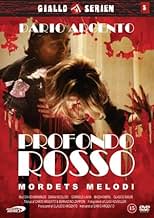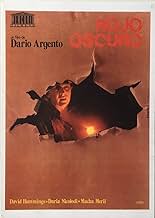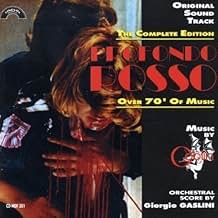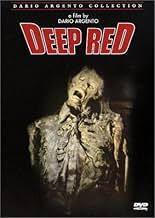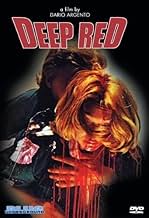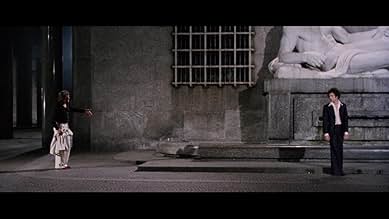Un pianista de jazz y un periodista al que le encantan las bromas se ven arrastrados a un complejo misterio cuando este último es testigo del brutal asesinato de un adivino.Un pianista de jazz y un periodista al que le encantan las bromas se ven arrastrados a un complejo misterio cuando este último es testigo del brutal asesinato de un adivino.Un pianista de jazz y un periodista al que le encantan las bromas se ven arrastrados a un complejo misterio cuando este último es testigo del brutal asesinato de un adivino.
- Dirección
- Guionistas
- Elenco
- Premios
- 1 premio ganado y 1 nominación en total
- Young Carlo
- (as Iacopo Mariani)
- Dirección
- Guionistas
- Todo el elenco y el equipo
- Producción, taquilla y más en IMDbPro
Opiniones destacadas
One of the best ¨Giallo¨with oneiric,effective esthetics packs lots of gore, guts and twists plots. This is a trademark terror work for the Horrormeister Argento with high tension quotient and equally high suspense by means of an ever-fluid camera that achieves colorful shots similarly to Giorgio De Chirico paintings. Noteworthy for intelligent edition work that tightens the mystery, glimmer use of color and distinctive utilization of shock images. Sometimes weak screenplay is added by nice but gory special effects by Carlo Rambaldi(ET).Screeching musical score by Goblin with stereophonic whispers combining to fortissimo soundtrack which help achieve incredible creepy moments.The terror pieces are well staged with eye-opening flair-play and contain obscure tracks to the denouement of the script.As trivia, Argento appears as murderer's hand. The motion picture is originally directed by Dario Argento, one of those film-makers(other examples are Mario Bava and Riccardo Freda ) who set off simple for frightening us to death. His period of biggest hits were the 70s when he directed the animals trilogy: ¨Four flies over gray velvet,The cat of nine tails, Bird with the crystal plumage¨, after he directed ¨Suspiria, Inferno, Tenebre¨ and of course ¨Deep red¨. This bloody fun plenty of graphic gore and weirdness may not be for all tastes but to be liked for Argento connoisseurs especially.
And now we are in 2005 ,and thirty years after,with hindsight ,that most fruitful part of Agento's works which begins with "Ucello della piume di cristalli"(1967) and ends -roughly- with "opera" (1987)shows how the frequently demeaned director was ahead of his time.Argento's work is art-house film!If Mario Bava or John Carpenter are,he is too.
Influenced by the former (color,lighting effects,depth of field,baroque settings),he had a strong influence on the latter,particularly for his use of music,which may seem trite at first listening but literally grows on you and leaves you completely panting for breath.
There's really an Argentesque geometry,a non -Euclidean one,and few other directors ( Alfred Hitchcock , Roman Polanski ) know how to depict a place and make it threatening for his characters.Argento,who certainly read Gaston Leroux ("le fantôme de l'opera" ) when he was young,loves the opera houses(or theater)."profondo rosso" begins on a stage where some kind of medium (Macha Meril) sees horrible things.People who have read Hergé's adventures of Tintin will notice the similarities between this scene and those pages in "the seven crystal balls" where Tintin and Haddock are watching Mrs Yamilah in a music hall."Opera" 's first scene also would take place in a theater as if the director told us "it's only a movie,do not worry" before treating us to the delight of the best scene with birds since Hitchcock's eponymous movie.
The sense of space which Argento displays is mind-boggling: depth of field,high and low angle shots,impressive lighting effects.His characters become Tom Thumb lost in the huge forest:think of the ballerina ,running away through the corridors ("Suspiria" ),James Franciscus in the graveyard ("il gatto...) ,Tony Musante in the lighthouse (Ucello ...),or Irene Miracle in the basement (Inferno).Here it's a true anthology:almost every place is memorable,from the corridor where the drama is resolved to the house where bad things happened long ago ,from the isolated house in the country -where Argento uses condensation as only a Conan Doyle,a Gaston Leroux or an Ellery Queen could have done it- to the school where weird drawings might be the final clue.To top it all,there's a sensational scene in a corridor ,which recalls Orson Welles' "lady from Shanghai.A "they do it with mirrors" trick which is still very impressive today.
Not only Argento creates fear with his disturbing settings ,but he makes us also ill-at-ease with his supporting cast:the gay with the androgynous face,the little girl who seems to be out of Fellini's "Toby Dammit" (1968),and of course Clara Calamai who was famous in the fascist years (Visconti's "ossessione" from "the postman always rings twice").
What about the screenplay?Well,like all Argento's movies I mention ,it's far-fetched and derivative ("psycho" ,"Marnie" for the final flashback).But it's delightfully far-fetched and smartly derivative .When today's horror flicks screenplays consist of one page (maybe two)of clichés ,Argento's ones have always been painstaking and labyrinthine .
It is one of the best works in Argento's much debated but absorbing filmography.No horror movie buff can ignore him.
This film is written by Bernardino Zapponi ("Anal Paprika") and directed by Italian horror giant Dario Argento ("Tenebre", "Phenomena", "Inferno"). And I have to say this right away: as much as I love this film and think it's one of Argento's better pieces, why is it more highly rated than "Suspiria"? Internet Movie Database ranks this in their top 50 horror films, while "Suspiria" is mysteriously absent. "Suspiria" is the better film in almost every way. But anyway...
This film really excels in the writing of both characters and plot. The lead is very interesting (Marcus Daly) even though he really only acts as a catalyst for events and as a surrogate for the viewer, taking us where we couldn't go without a guide. Much of the plot is convoluted in the version I watched (the heavily edited English version, as I don't speak much Italian like my sister does), but still comes off as very well layered.
The gore is not as bad as some may have made it out to be. Even by 1970s standards, it's nothing really shocking. But it works. One scene, involving a woman killed with hot water, was well done. Another, with a man getting his teeth bashed out on the corner of a table, was not as gruesome as it could have been but was still painful to watch. The creepiest part (I actually felt uneasy) was when there was... a killer doll! It was just really creepy in the style of the presentation.
You can't talk about Argento's films without talking about the music. The band Goblin supplies the soundtrack (just like on "Suspiria") and does a fine job. One review found the music "annoying", and I can appreciate that sentiment. They do repeat the same songs over a lot, and the music isn't as blended in as it should be. But the songs themselves are moving and very good at burrowing into your subconscious. The theme to "Suspiria" is great (I have the soundtrack and it's awesome), and these songs are also really good. There's just something about them -- horror doesn't embrace music as often as it should. Think about the great horror themes, and try to imagine the films without them. Music is essential.
I look forward to someday seeing the Anchor Bay release of this film, as I'd love to see the edited parts. But I definitely recommend you see this if you have the chance. Sure, it's older and the quality isn't that stellar. Stop whining! Films should be judged on plot, acting and vision. Don't blame a director in the 1970s for not owning 1990s equipment. This one is a winner, although I have to disagree with the IMDb voters about it being the best Argento... maybe second best (which is still better than almost any other director out there).
The film is the story of Marcus Daly (David Hemmings), a British piano player who is spending some time in Italy as a music teacher. One night after work, as he walks towards his apartment, he watches through the building's window and notices his neighbor Helga (Macha Méril) struggling with an unknown man. Helga, a psychic, gets brutally killed in front of Daly's eyes, who runs towards the apartment in a futile attempt to save her. After being interrogated by the police, Daly notices that he could have seen the killer's face among a group of portraits on the wall, but he can't truly figure out what's missing. This thought becomes an obsession and Daly decides to investigate the murder of the psychic with the help of reporter Gianna Brezzi (Daria Nicolodi), however, his obsession becomes dangerous as he becomes the killer's next target.
Written by Bernardino Zapponi and Dario Argento himself, the film's plot revolves around the solving of the mystery while putting special attention to Marcus' obsession with the missing clue he may have caught the night of the murder. While Argento is famous for preferring surrealism to logic when writing his screenplays, the story in "Profondo Rosso" is carefully constructed and takes advantage of every element of the Giallo genre to tell it's mystery. And mystery is the key of the film, as the secret of the killer's identity is exploited to the max in order to create wonderful set pieces of suspense and horror. The care taken to develop the characters is another of the things that make "Profondo Rosso" to stand out among similar films, a not only Daly's obsessions are explored, but his relation with Gianna becomes an interesting source of romance, some comedy, and lots of suspense.
By the time he directed "Profondo Rosso", Dario Argento was already a master of his craft with a defined style, and the whole look of the film demonstrates it. With his excellent visual composition and inventive use of the camera (with cinematographer Luigi Kuveiller), Argento shows that he knows how to build up suspense and tension in the audience; and together with the excellent make-up by Giuliano Laurenti and Giovanni Morosi, Argento creates some of the most amazing murder scenes ever put to film. Giallo films are famous for making an art of their murder scenes, and in "Profondo Rosso" Argento takes that idea to the next level. The effective score by Giorgio Gaslini and the band "Goblin" is the icing on the cake, as it completes the unnatural haunting atmosphere that the whole film has.
Leading the cast is David Hemmings as Marcus Daly, in what seems to be almost a reprisal of his role in Antonioni's 1966 film, "Blowup" (which was another of Argento's inspirations). Hemmings is excellent in his role, and effectively portrays Daly's own descent into darkness as he gets more involved with the killings. Argento's regular collaborator Daria Nicolodi stars as Gianna Brezzi (in her first work with Argento), an interesting role because the character demands her to downplay her beauty in favor of the awkwardness of the role. Nicolodi is charming, and very natural, making hard to not fall in love with her character, the typical wisecracking reporter of mystery films. The rest of the cast includes many interesting characters (everyone is a suspect here), and the supporting actors do a very good job. Gabriele Lavie is specially great as Carlo, making probably the most likable character of the film.
While definitely one of the best Giallo films ever made, "Profondo Rosso" is not exempt of flaws, at least in my humble opinion. The most noticeable I found was the fact that at times the plot kind of drags, wasting too much time in details that do not advance the plot. This makes the long runtime feel even longer than it should, and due to this some audiences may feel the film is boring. Fortunately, this doesn't happen too often and it's more a minor quibble than an actual flaw. Another detail that bothered me was the bad dubbing the film has, and I don't mean the English dubbing, the original Italian work of audio is really bad, and diminishes the value of many of the performances due to bad synchronization between audio and voice work.
As one of the modern masters of horror, Dario Argento's career is one of enormous value for horror fans, and among his many works, "Profondo Rosso" is an essential one. A remarkable work of style and technique, "Deep Red" is a movie that simply grabs you and doesn't let you go until it ends, making an excellent experience and a good companion piece to Argento's follow-up, the masterpiece "Suspiria". Without a doubt "Profondo Rosso" is one of the best murder-mystery films ever made. A true jewel. 9/10
¿Sabías que…?
- TriviaCo-writer Bernardino Zapponi said the inspiration behind the murder scenes came from him and Dario Argento thinking of painful injuries that the audience could relate to. Basically, not everyone knows the pain of being shot by a gun, but everyone has at some point accidentally struck furniture or been scalded by hot water.
- ErroresWhen Helga Ulmann is introduced during the séance, she is said to be Lithuanian. When her murder is announced on the TV later in the film she is said to be German, which would explain her talking in German on the telephone just before the murder.
- Citas
Helga Ulmann: It was - I can't explain it - something strange and sharp, like the prick of a thorn. It upset me, but it's all right now.
[Gasps]
Helga Ulmann: I can feel death in this room! I feel a presence, a twisted mind sending me thoughts! Perverted, murderous thoughts... Go away! You have killed! And you will kill again!
- Créditos curiosos"You have just seen Deep Red."
- Versiones alternativasOriginal Italian version is 120 minutes long. Most US versions remove 22 minutes worth of footage mostly for pacing, including some graphic violence, all humorous scenes, almost all of the romantic scenes between David Hemmings and Daria Nicolodi and part of the subplot regarding the house of the screaming child.
- ConexionesFeatured in El mundo de horror de Dario Argento (1985)
- Bandas sonorasSchool At Night (Lullaby)
(uncredited)
Composed by Giorgio Gaslini
Orchestrated by Giorgio Gaslini
Conducted by Giorgio Gaslini
[Played by killer on tape recorder]
Selecciones populares
Detalles
Taquilla
- Total a nivel mundial
- USD 68,473
- Tiempo de ejecución
- 2h 7min(127 min)
- Mezcla de sonido
- Relación de aspecto
- 2.35 : 1



